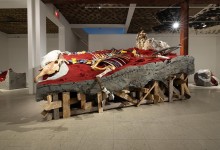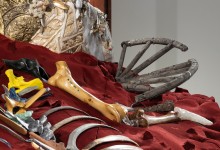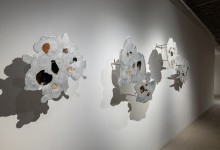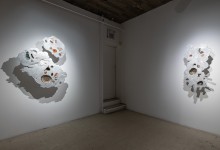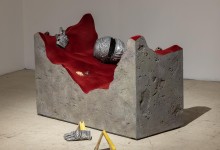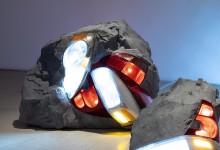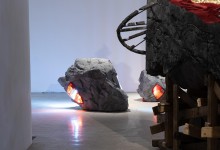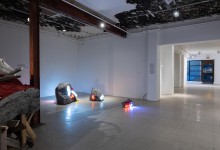Opening reception: Saturday, May 6, 2023 from 3 p.m. to 5 p.m.
Nicholas Crombach: Landslip
Text by Helen Gregory
A collision. A landslide. A tectonic shift and a tumbling of boulders reveal geological strata that have been hidden for centuries. Nicholas Crombach’s Landslip is a slow unfurling of a glorious disaster, an asynchronous set of catastrophes that collide into a single moment. Both gorgeous and tragic, the exhibition revels in the tension between Crombach’s sumptuous, almost Baroque aesthetic and the feeling that we are witnessing carnage in the aftermath of an accident. Time slips and folds in on itself: a moment of temporal compression where dissociated tragi-comic disasters suddenly coincide, creating an ambiguous theatrical tableau that defies categorization. What are we looking at? An archaeological dig? A construction zone? A traffic accident? Landslip is a study in parallels between the tectonic shifts that expose previously hidden geological forms and human acts of archaeological excavation. In both cases, it is only through an act of destruction that something new is discovered.
Focusing on a world in which natural and human materials are irrevocably fused, Crombach considers the twinned studies of archaeology and geology through an Anthropogenic lens: slow excavations of long obscured stories, unearthed through human intervention or the slow erosion that occurs over millennia. Chariot Burial, based on an iron age practice in which the deceased were entombed with their horses, chariots, shields, and other accoutrements, is reimagined and re-presented as a car crash of colours, materials, and textures. Crombach employs multiple techniques to create handcrafted bones, chariot wheels, and a velvet flocked armature to conflate ancient burial practices, archeological methodologies, and systems of museological storage and display.
The embedding of one material into another is repeated in Crombach’s study of xenoliths, a geological phenomenon whereby rocks become encapsulated in magma as it cools. Crombach’s Xenolith series capitalizes on the visual correlation to inlay work in which shell or other decorative materials are carefully inserted into wood or stone and polished to a smooth cohesive surface. Quasi-recognizable objects are here captured in once molten aluminum and, like stones caught in cooling magma, some retain a familiar structure while others are rendered indistinguishable.
In geology, erratics are boulders that have been lifted, transported, and deposited elsewhere through the movement of glacial fields, resulting in anomalous objects that bear no geological relationship to the landscape in which they have come to rest. To create Erratic Boulders, Crombach utilizes the semiotic potential of his materials, combining automotive headlights with high-density foam used in museum display. The materials function as indices, pointing not only to the implication of tragedy but also to the mimetic quality of a theatre set or museum diorama.
Landslip is a meditation on tectonic shifts and displacement, metamorphosis and transmutation, reality and simulacrum, and the increasingly blurred boundaries between nature and culture that characterize the current geological era. What beauty will we unearth along the way as we hurtle towards the inevitable, ineffable catastrophe that is the future?


